Nursing Care Plan: Mr. Jones, Diabetes, Wound Healing, and Nutrition
VerifiedAdded on 2020/05/28
|8
|2171
|1126
Report
AI Summary
This report presents a nursing care plan for a 70-year-old patient, Mr. Stephen Jones, who suffers from diabetes, impaired skin integrity, and nutritional imbalance following an open cholecystectomy. The report begins with an introduction to the patient's condition, highlighting the impact of diabetes on wound healing, including factors like impaired growth factor production, angiogenesis, immune response, and nutritional deficiencies. It discusses the physiology of wound healing, detailing the stages of hemostasis, inflammation, proliferation, and remodeling, along with the aetiology of impaired wound healing. The report then focuses on wound bed preparation, measurement, and the importance of periwound skin assessment. It covers wound exudates, treatment aims, and a comprehensive wound management plan, including wound assessment, cleansing, debridement, moisture balance management, infection control, and nutritional support. The report concludes with a nursing care plan designed to ensure proper wound assessment, management, and treatment for the patient.
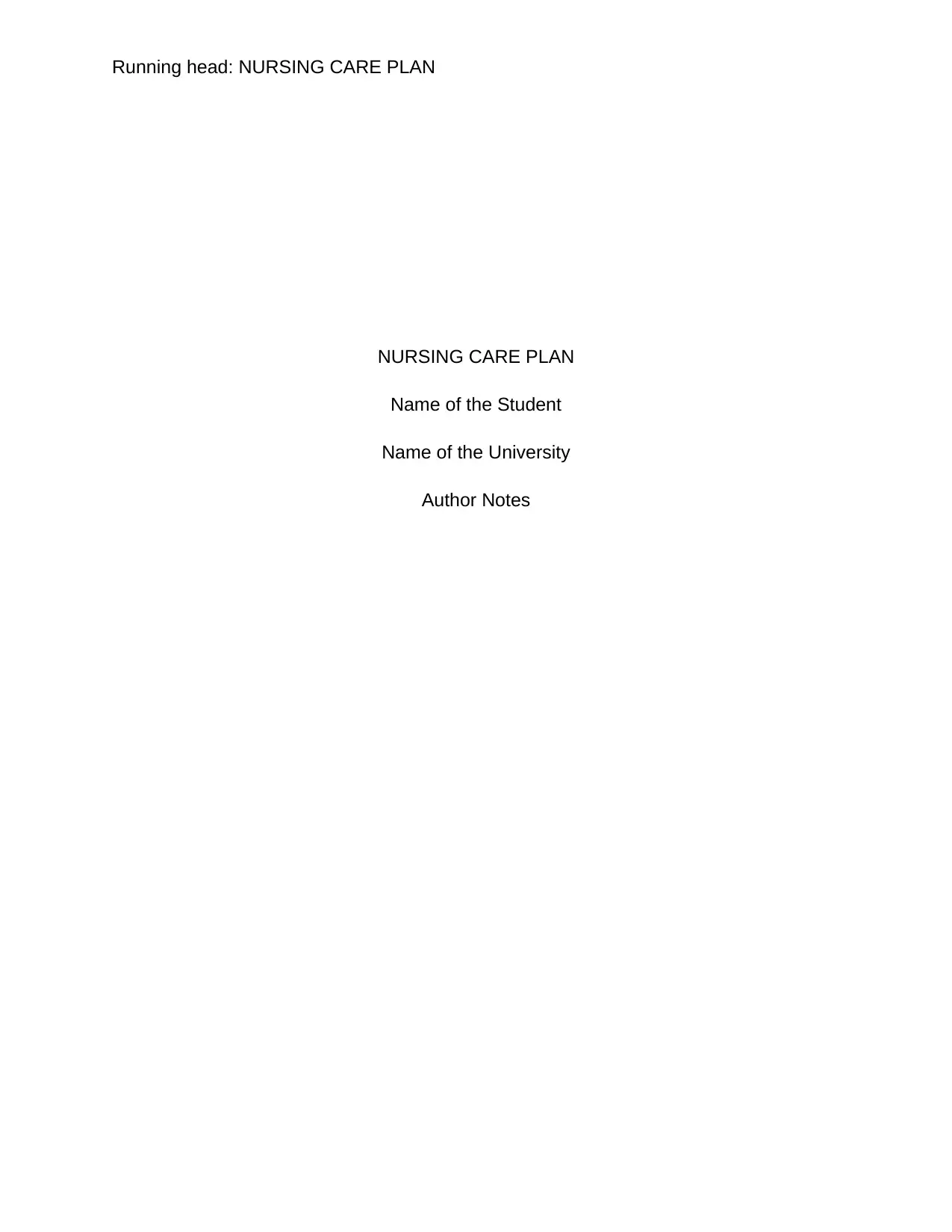
Running head: NURSING CARE PLAN
NURSING CARE PLAN
Name of the Student
Name of the University
Author Notes
NURSING CARE PLAN
Name of the Student
Name of the University
Author Notes
Paraphrase This Document
Need a fresh take? Get an instant paraphrase of this document with our AI Paraphraser
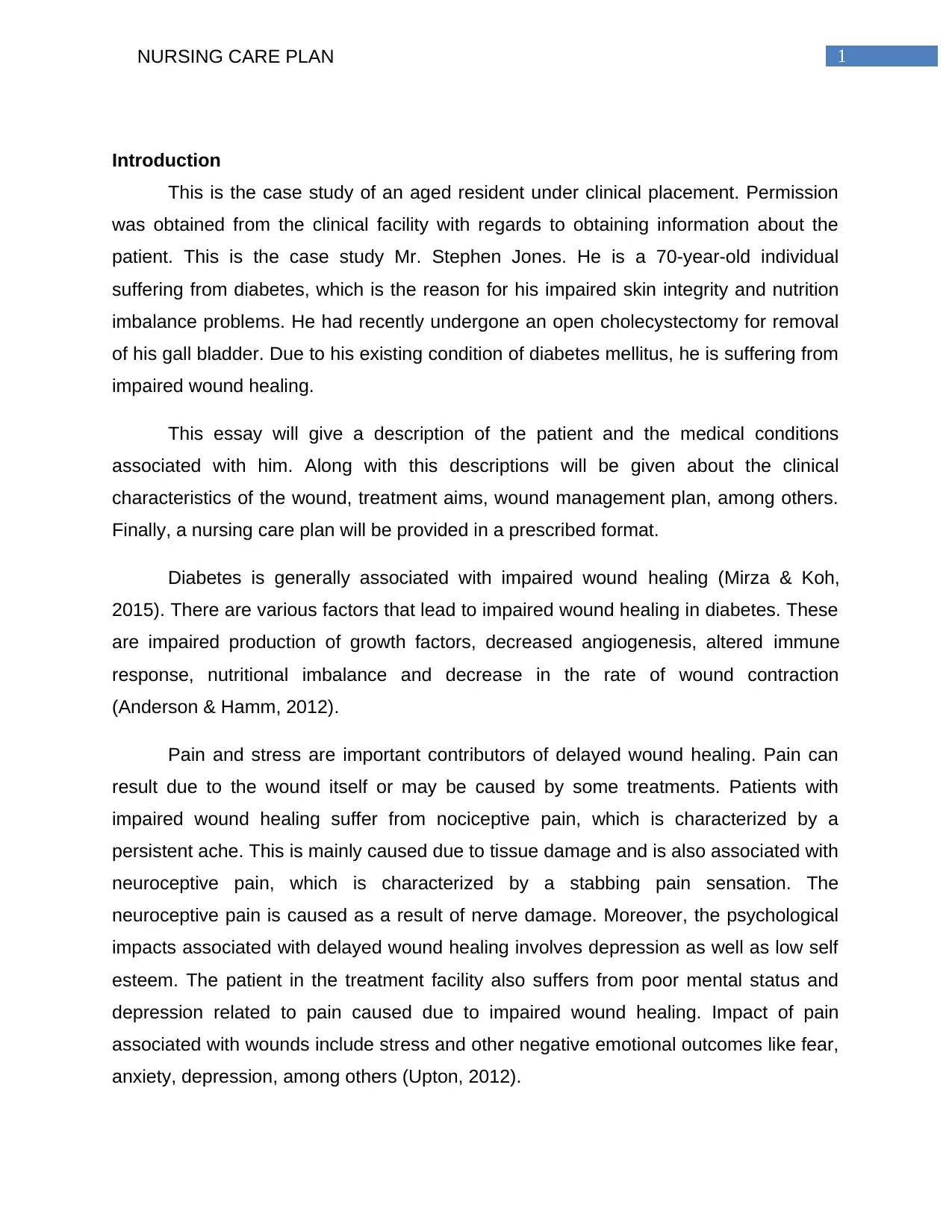
1NURSING CARE PLAN
Introduction
This is the case study of an aged resident under clinical placement. Permission
was obtained from the clinical facility with regards to obtaining information about the
patient. This is the case study Mr. Stephen Jones. He is a 70-year-old individual
suffering from diabetes, which is the reason for his impaired skin integrity and nutrition
imbalance problems. He had recently undergone an open cholecystectomy for removal
of his gall bladder. Due to his existing condition of diabetes mellitus, he is suffering from
impaired wound healing.
This essay will give a description of the patient and the medical conditions
associated with him. Along with this descriptions will be given about the clinical
characteristics of the wound, treatment aims, wound management plan, among others.
Finally, a nursing care plan will be provided in a prescribed format.
Diabetes is generally associated with impaired wound healing (Mirza & Koh,
2015). There are various factors that lead to impaired wound healing in diabetes. These
are impaired production of growth factors, decreased angiogenesis, altered immune
response, nutritional imbalance and decrease in the rate of wound contraction
(Anderson & Hamm, 2012).
Pain and stress are important contributors of delayed wound healing. Pain can
result due to the wound itself or may be caused by some treatments. Patients with
impaired wound healing suffer from nociceptive pain, which is characterized by a
persistent ache. This is mainly caused due to tissue damage and is also associated with
neuroceptive pain, which is characterized by a stabbing pain sensation. The
neuroceptive pain is caused as a result of nerve damage. Moreover, the psychological
impacts associated with delayed wound healing involves depression as well as low self
esteem. The patient in the treatment facility also suffers from poor mental status and
depression related to pain caused due to impaired wound healing. Impact of pain
associated with wounds include stress and other negative emotional outcomes like fear,
anxiety, depression, among others (Upton, 2012).
Introduction
This is the case study of an aged resident under clinical placement. Permission
was obtained from the clinical facility with regards to obtaining information about the
patient. This is the case study Mr. Stephen Jones. He is a 70-year-old individual
suffering from diabetes, which is the reason for his impaired skin integrity and nutrition
imbalance problems. He had recently undergone an open cholecystectomy for removal
of his gall bladder. Due to his existing condition of diabetes mellitus, he is suffering from
impaired wound healing.
This essay will give a description of the patient and the medical conditions
associated with him. Along with this descriptions will be given about the clinical
characteristics of the wound, treatment aims, wound management plan, among others.
Finally, a nursing care plan will be provided in a prescribed format.
Diabetes is generally associated with impaired wound healing (Mirza & Koh,
2015). There are various factors that lead to impaired wound healing in diabetes. These
are impaired production of growth factors, decreased angiogenesis, altered immune
response, nutritional imbalance and decrease in the rate of wound contraction
(Anderson & Hamm, 2012).
Pain and stress are important contributors of delayed wound healing. Pain can
result due to the wound itself or may be caused by some treatments. Patients with
impaired wound healing suffer from nociceptive pain, which is characterized by a
persistent ache. This is mainly caused due to tissue damage and is also associated with
neuroceptive pain, which is characterized by a stabbing pain sensation. The
neuroceptive pain is caused as a result of nerve damage. Moreover, the psychological
impacts associated with delayed wound healing involves depression as well as low self
esteem. The patient in the treatment facility also suffers from poor mental status and
depression related to pain caused due to impaired wound healing. Impact of pain
associated with wounds include stress and other negative emotional outcomes like fear,
anxiety, depression, among others (Upton, 2012).
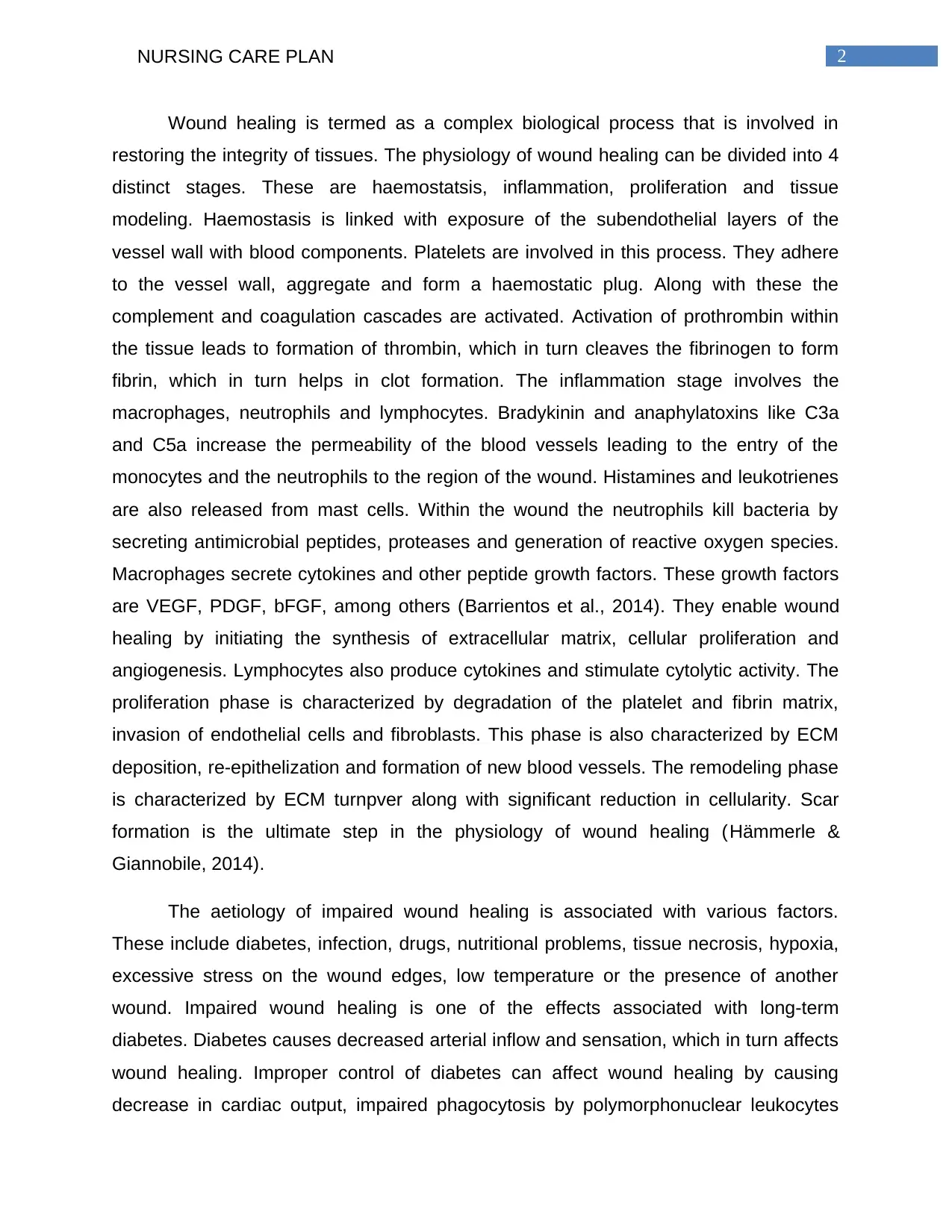
2NURSING CARE PLAN
Wound healing is termed as a complex biological process that is involved in
restoring the integrity of tissues. The physiology of wound healing can be divided into 4
distinct stages. These are haemostatsis, inflammation, proliferation and tissue
modeling. Haemostasis is linked with exposure of the subendothelial layers of the
vessel wall with blood components. Platelets are involved in this process. They adhere
to the vessel wall, aggregate and form a haemostatic plug. Along with these the
complement and coagulation cascades are activated. Activation of prothrombin within
the tissue leads to formation of thrombin, which in turn cleaves the fibrinogen to form
fibrin, which in turn helps in clot formation. The inflammation stage involves the
macrophages, neutrophils and lymphocytes. Bradykinin and anaphylatoxins like C3a
and C5a increase the permeability of the blood vessels leading to the entry of the
monocytes and the neutrophils to the region of the wound. Histamines and leukotrienes
are also released from mast cells. Within the wound the neutrophils kill bacteria by
secreting antimicrobial peptides, proteases and generation of reactive oxygen species.
Macrophages secrete cytokines and other peptide growth factors. These growth factors
are VEGF, PDGF, bFGF, among others (Barrientos et al., 2014). They enable wound
healing by initiating the synthesis of extracellular matrix, cellular proliferation and
angiogenesis. Lymphocytes also produce cytokines and stimulate cytolytic activity. The
proliferation phase is characterized by degradation of the platelet and fibrin matrix,
invasion of endothelial cells and fibroblasts. This phase is also characterized by ECM
deposition, re-epithelization and formation of new blood vessels. The remodeling phase
is characterized by ECM turnpver along with significant reduction in cellularity. Scar
formation is the ultimate step in the physiology of wound healing (Hämmerle &
Giannobile, 2014).
The aetiology of impaired wound healing is associated with various factors.
These include diabetes, infection, drugs, nutritional problems, tissue necrosis, hypoxia,
excessive stress on the wound edges, low temperature or the presence of another
wound. Impaired wound healing is one of the effects associated with long-term
diabetes. Diabetes causes decreased arterial inflow and sensation, which in turn affects
wound healing. Improper control of diabetes can affect wound healing by causing
decrease in cardiac output, impaired phagocytosis by polymorphonuclear leukocytes
Wound healing is termed as a complex biological process that is involved in
restoring the integrity of tissues. The physiology of wound healing can be divided into 4
distinct stages. These are haemostatsis, inflammation, proliferation and tissue
modeling. Haemostasis is linked with exposure of the subendothelial layers of the
vessel wall with blood components. Platelets are involved in this process. They adhere
to the vessel wall, aggregate and form a haemostatic plug. Along with these the
complement and coagulation cascades are activated. Activation of prothrombin within
the tissue leads to formation of thrombin, which in turn cleaves the fibrinogen to form
fibrin, which in turn helps in clot formation. The inflammation stage involves the
macrophages, neutrophils and lymphocytes. Bradykinin and anaphylatoxins like C3a
and C5a increase the permeability of the blood vessels leading to the entry of the
monocytes and the neutrophils to the region of the wound. Histamines and leukotrienes
are also released from mast cells. Within the wound the neutrophils kill bacteria by
secreting antimicrobial peptides, proteases and generation of reactive oxygen species.
Macrophages secrete cytokines and other peptide growth factors. These growth factors
are VEGF, PDGF, bFGF, among others (Barrientos et al., 2014). They enable wound
healing by initiating the synthesis of extracellular matrix, cellular proliferation and
angiogenesis. Lymphocytes also produce cytokines and stimulate cytolytic activity. The
proliferation phase is characterized by degradation of the platelet and fibrin matrix,
invasion of endothelial cells and fibroblasts. This phase is also characterized by ECM
deposition, re-epithelization and formation of new blood vessels. The remodeling phase
is characterized by ECM turnpver along with significant reduction in cellularity. Scar
formation is the ultimate step in the physiology of wound healing (Hämmerle &
Giannobile, 2014).
The aetiology of impaired wound healing is associated with various factors.
These include diabetes, infection, drugs, nutritional problems, tissue necrosis, hypoxia,
excessive stress on the wound edges, low temperature or the presence of another
wound. Impaired wound healing is one of the effects associated with long-term
diabetes. Diabetes causes decreased arterial inflow and sensation, which in turn affects
wound healing. Improper control of diabetes can affect wound healing by causing
decrease in cardiac output, impaired phagocytosis by polymorphonuclear leukocytes
⊘ This is a preview!⊘
Do you want full access?
Subscribe today to unlock all pages.

Trusted by 1+ million students worldwide
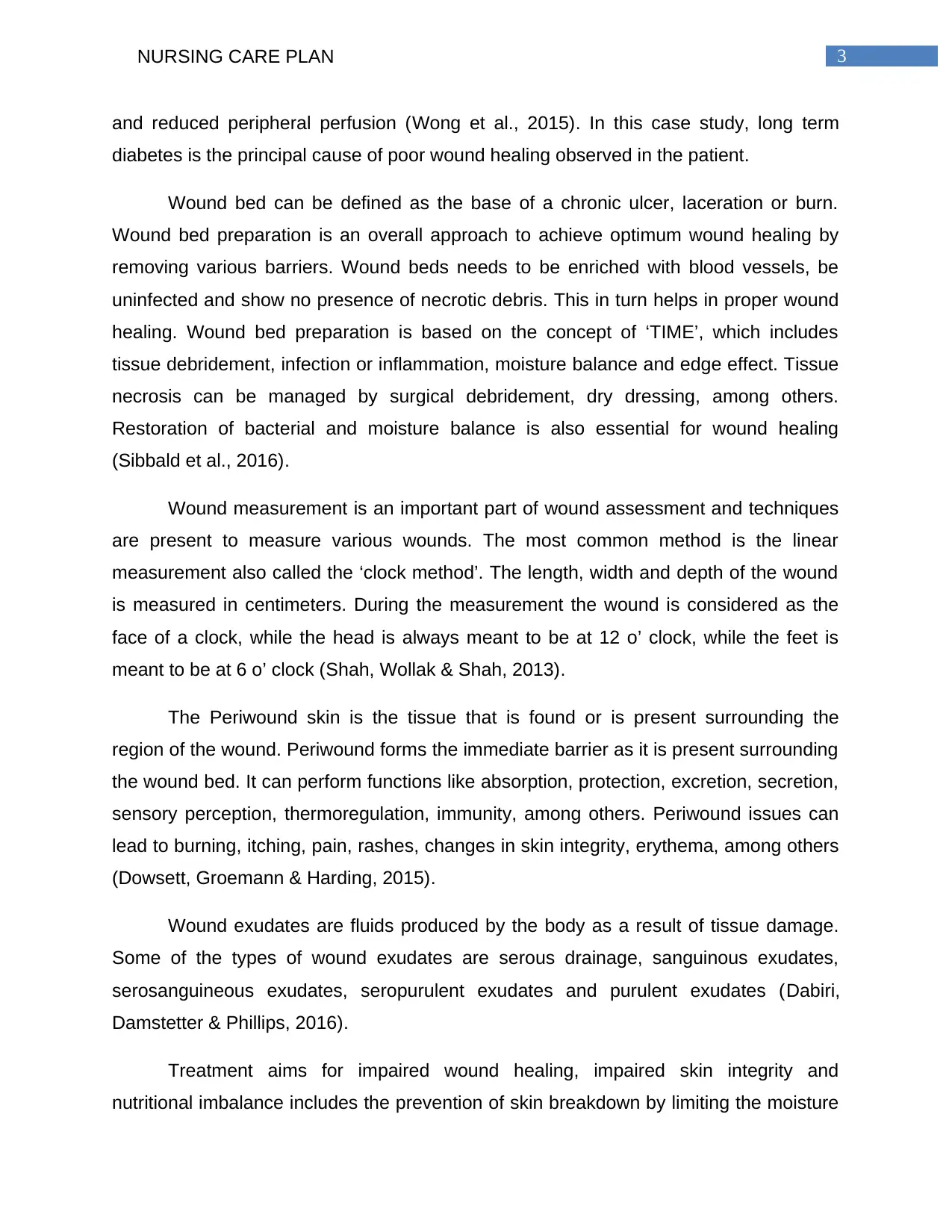
3NURSING CARE PLAN
and reduced peripheral perfusion (Wong et al., 2015). In this case study, long term
diabetes is the principal cause of poor wound healing observed in the patient.
Wound bed can be defined as the base of a chronic ulcer, laceration or burn.
Wound bed preparation is an overall approach to achieve optimum wound healing by
removing various barriers. Wound beds needs to be enriched with blood vessels, be
uninfected and show no presence of necrotic debris. This in turn helps in proper wound
healing. Wound bed preparation is based on the concept of ‘TIME’, which includes
tissue debridement, infection or inflammation, moisture balance and edge effect. Tissue
necrosis can be managed by surgical debridement, dry dressing, among others.
Restoration of bacterial and moisture balance is also essential for wound healing
(Sibbald et al., 2016).
Wound measurement is an important part of wound assessment and techniques
are present to measure various wounds. The most common method is the linear
measurement also called the ‘clock method’. The length, width and depth of the wound
is measured in centimeters. During the measurement the wound is considered as the
face of a clock, while the head is always meant to be at 12 o’ clock, while the feet is
meant to be at 6 o’ clock (Shah, Wollak & Shah, 2013).
The Periwound skin is the tissue that is found or is present surrounding the
region of the wound. Periwound forms the immediate barrier as it is present surrounding
the wound bed. It can perform functions like absorption, protection, excretion, secretion,
sensory perception, thermoregulation, immunity, among others. Periwound issues can
lead to burning, itching, pain, rashes, changes in skin integrity, erythema, among others
(Dowsett, Groemann & Harding, 2015).
Wound exudates are fluids produced by the body as a result of tissue damage.
Some of the types of wound exudates are serous drainage, sanguinous exudates,
serosanguineous exudates, seropurulent exudates and purulent exudates (Dabiri,
Damstetter & Phillips, 2016).
Treatment aims for impaired wound healing, impaired skin integrity and
nutritional imbalance includes the prevention of skin breakdown by limiting the moisture
and reduced peripheral perfusion (Wong et al., 2015). In this case study, long term
diabetes is the principal cause of poor wound healing observed in the patient.
Wound bed can be defined as the base of a chronic ulcer, laceration or burn.
Wound bed preparation is an overall approach to achieve optimum wound healing by
removing various barriers. Wound beds needs to be enriched with blood vessels, be
uninfected and show no presence of necrotic debris. This in turn helps in proper wound
healing. Wound bed preparation is based on the concept of ‘TIME’, which includes
tissue debridement, infection or inflammation, moisture balance and edge effect. Tissue
necrosis can be managed by surgical debridement, dry dressing, among others.
Restoration of bacterial and moisture balance is also essential for wound healing
(Sibbald et al., 2016).
Wound measurement is an important part of wound assessment and techniques
are present to measure various wounds. The most common method is the linear
measurement also called the ‘clock method’. The length, width and depth of the wound
is measured in centimeters. During the measurement the wound is considered as the
face of a clock, while the head is always meant to be at 12 o’ clock, while the feet is
meant to be at 6 o’ clock (Shah, Wollak & Shah, 2013).
The Periwound skin is the tissue that is found or is present surrounding the
region of the wound. Periwound forms the immediate barrier as it is present surrounding
the wound bed. It can perform functions like absorption, protection, excretion, secretion,
sensory perception, thermoregulation, immunity, among others. Periwound issues can
lead to burning, itching, pain, rashes, changes in skin integrity, erythema, among others
(Dowsett, Groemann & Harding, 2015).
Wound exudates are fluids produced by the body as a result of tissue damage.
Some of the types of wound exudates are serous drainage, sanguinous exudates,
serosanguineous exudates, seropurulent exudates and purulent exudates (Dabiri,
Damstetter & Phillips, 2016).
Treatment aims for impaired wound healing, impaired skin integrity and
nutritional imbalance includes the prevention of skin breakdown by limiting the moisture
Paraphrase This Document
Need a fresh take? Get an instant paraphrase of this document with our AI Paraphraser
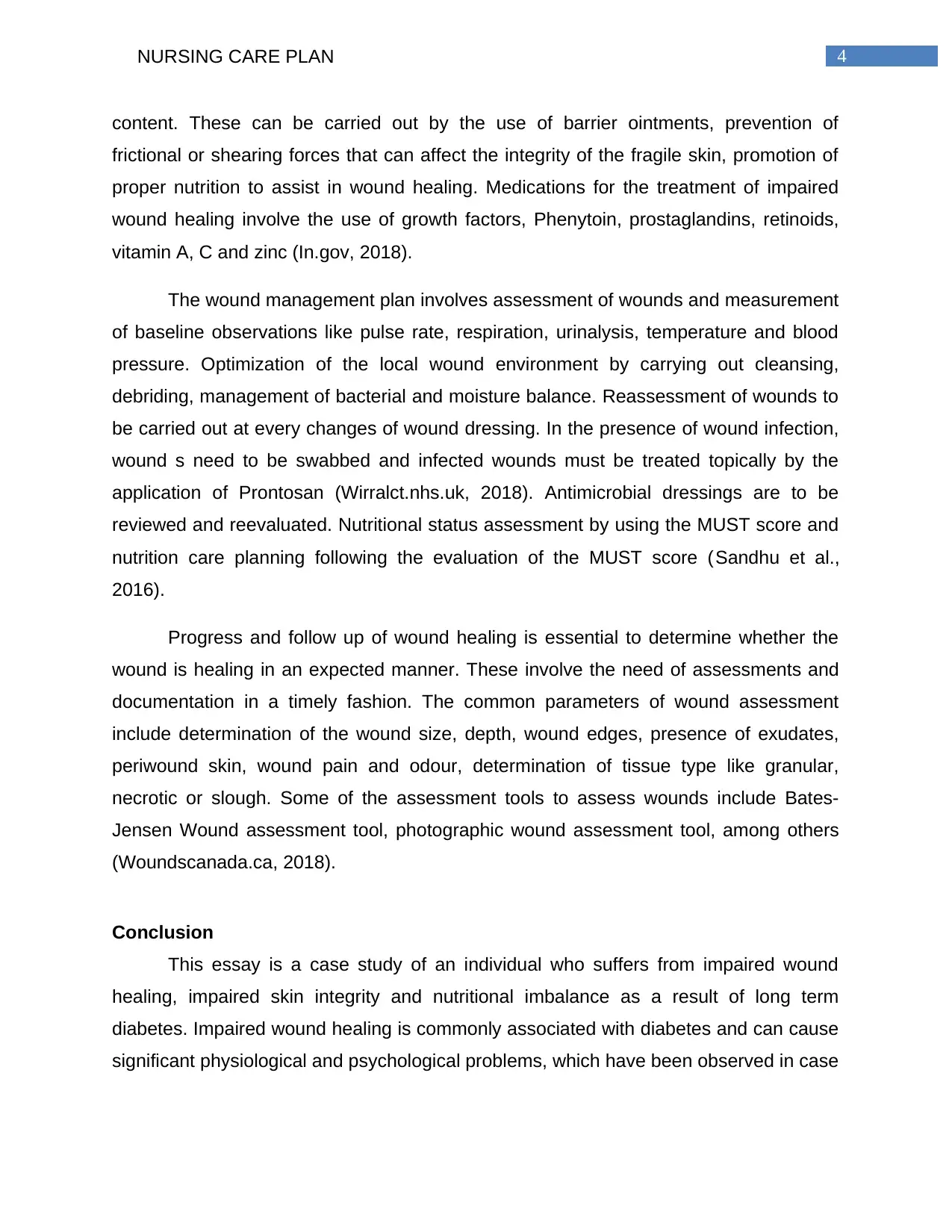
4NURSING CARE PLAN
content. These can be carried out by the use of barrier ointments, prevention of
frictional or shearing forces that can affect the integrity of the fragile skin, promotion of
proper nutrition to assist in wound healing. Medications for the treatment of impaired
wound healing involve the use of growth factors, Phenytoin, prostaglandins, retinoids,
vitamin A, C and zinc (In.gov, 2018).
The wound management plan involves assessment of wounds and measurement
of baseline observations like pulse rate, respiration, urinalysis, temperature and blood
pressure. Optimization of the local wound environment by carrying out cleansing,
debriding, management of bacterial and moisture balance. Reassessment of wounds to
be carried out at every changes of wound dressing. In the presence of wound infection,
wound s need to be swabbed and infected wounds must be treated topically by the
application of Prontosan (Wirralct.nhs.uk, 2018). Antimicrobial dressings are to be
reviewed and reevaluated. Nutritional status assessment by using the MUST score and
nutrition care planning following the evaluation of the MUST score (Sandhu et al.,
2016).
Progress and follow up of wound healing is essential to determine whether the
wound is healing in an expected manner. These involve the need of assessments and
documentation in a timely fashion. The common parameters of wound assessment
include determination of the wound size, depth, wound edges, presence of exudates,
periwound skin, wound pain and odour, determination of tissue type like granular,
necrotic or slough. Some of the assessment tools to assess wounds include Bates-
Jensen Wound assessment tool, photographic wound assessment tool, among others
(Woundscanada.ca, 2018).
Conclusion
This essay is a case study of an individual who suffers from impaired wound
healing, impaired skin integrity and nutritional imbalance as a result of long term
diabetes. Impaired wound healing is commonly associated with diabetes and can cause
significant physiological and psychological problems, which have been observed in case
content. These can be carried out by the use of barrier ointments, prevention of
frictional or shearing forces that can affect the integrity of the fragile skin, promotion of
proper nutrition to assist in wound healing. Medications for the treatment of impaired
wound healing involve the use of growth factors, Phenytoin, prostaglandins, retinoids,
vitamin A, C and zinc (In.gov, 2018).
The wound management plan involves assessment of wounds and measurement
of baseline observations like pulse rate, respiration, urinalysis, temperature and blood
pressure. Optimization of the local wound environment by carrying out cleansing,
debriding, management of bacterial and moisture balance. Reassessment of wounds to
be carried out at every changes of wound dressing. In the presence of wound infection,
wound s need to be swabbed and infected wounds must be treated topically by the
application of Prontosan (Wirralct.nhs.uk, 2018). Antimicrobial dressings are to be
reviewed and reevaluated. Nutritional status assessment by using the MUST score and
nutrition care planning following the evaluation of the MUST score (Sandhu et al.,
2016).
Progress and follow up of wound healing is essential to determine whether the
wound is healing in an expected manner. These involve the need of assessments and
documentation in a timely fashion. The common parameters of wound assessment
include determination of the wound size, depth, wound edges, presence of exudates,
periwound skin, wound pain and odour, determination of tissue type like granular,
necrotic or slough. Some of the assessment tools to assess wounds include Bates-
Jensen Wound assessment tool, photographic wound assessment tool, among others
(Woundscanada.ca, 2018).
Conclusion
This essay is a case study of an individual who suffers from impaired wound
healing, impaired skin integrity and nutritional imbalance as a result of long term
diabetes. Impaired wound healing is commonly associated with diabetes and can cause
significant physiological and psychological problems, which have been observed in case
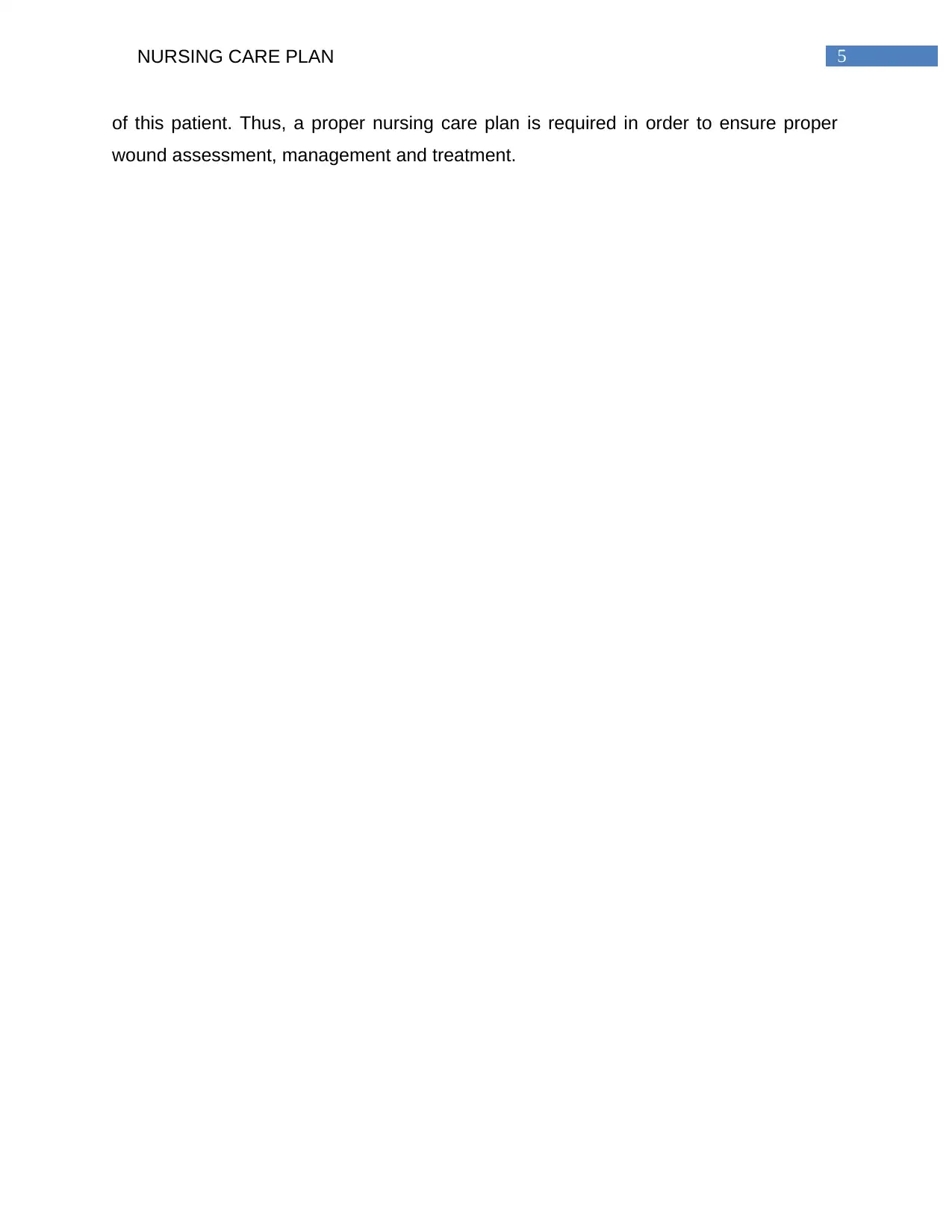
5NURSING CARE PLAN
of this patient. Thus, a proper nursing care plan is required in order to ensure proper
wound assessment, management and treatment.
of this patient. Thus, a proper nursing care plan is required in order to ensure proper
wound assessment, management and treatment.
⊘ This is a preview!⊘
Do you want full access?
Subscribe today to unlock all pages.

Trusted by 1+ million students worldwide
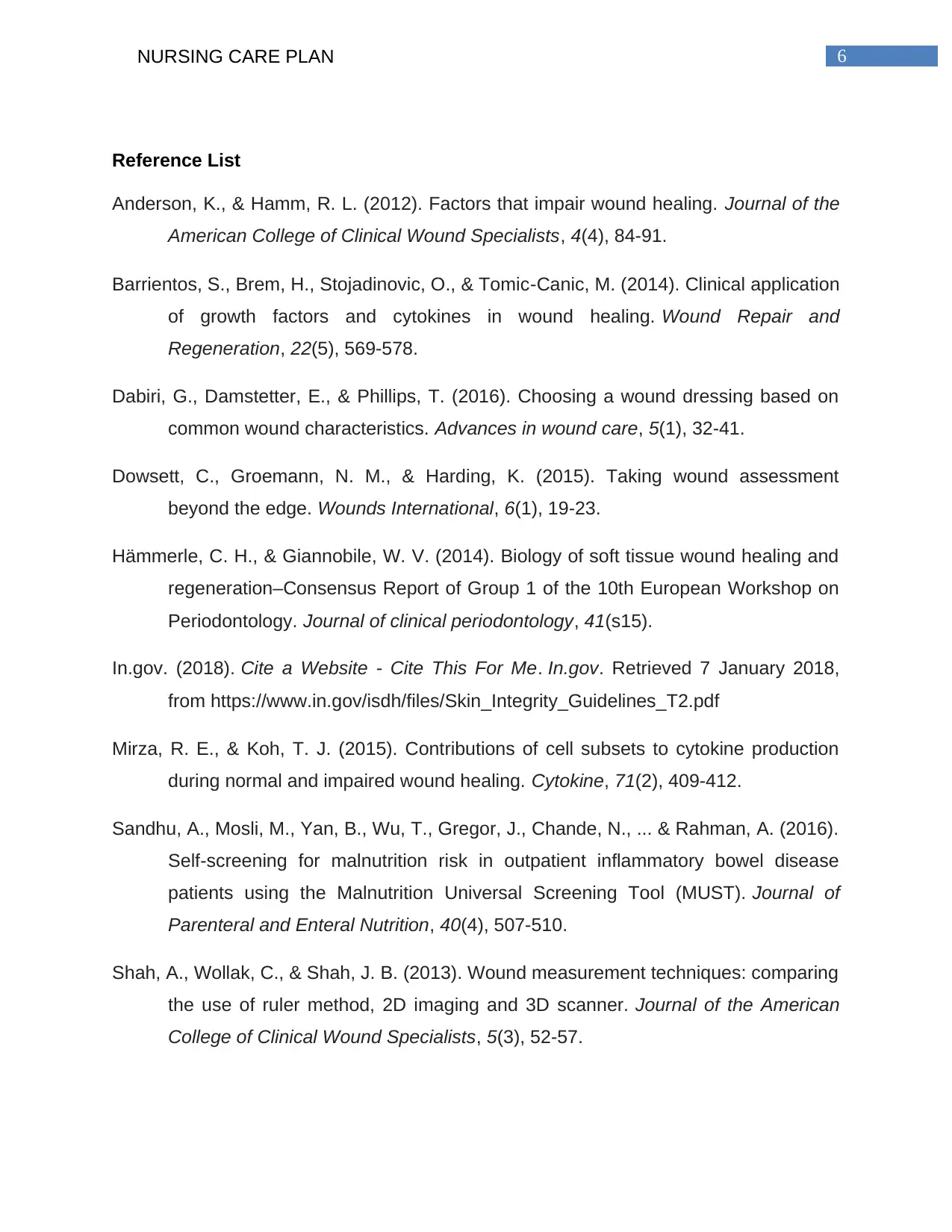
6NURSING CARE PLAN
Reference List
Anderson, K., & Hamm, R. L. (2012). Factors that impair wound healing. Journal of the
American College of Clinical Wound Specialists, 4(4), 84-91.
Barrientos, S., Brem, H., Stojadinovic, O., & Tomic‐Canic, M. (2014). Clinical application
of growth factors and cytokines in wound healing. Wound Repair and
Regeneration, 22(5), 569-578.
Dabiri, G., Damstetter, E., & Phillips, T. (2016). Choosing a wound dressing based on
common wound characteristics. Advances in wound care, 5(1), 32-41.
Dowsett, C., Groemann, N. M., & Harding, K. (2015). Taking wound assessment
beyond the edge. Wounds International, 6(1), 19-23.
Hämmerle, C. H., & Giannobile, W. V. (2014). Biology of soft tissue wound healing and
regeneration–Consensus Report of Group 1 of the 10th European Workshop on
Periodontology. Journal of clinical periodontology, 41(s15).
In.gov. (2018). Cite a Website - Cite This For Me. In.gov. Retrieved 7 January 2018,
from https://www.in.gov/isdh/files/Skin_Integrity_Guidelines_T2.pdf
Mirza, R. E., & Koh, T. J. (2015). Contributions of cell subsets to cytokine production
during normal and impaired wound healing. Cytokine, 71(2), 409-412.
Sandhu, A., Mosli, M., Yan, B., Wu, T., Gregor, J., Chande, N., ... & Rahman, A. (2016).
Self-screening for malnutrition risk in outpatient inflammatory bowel disease
patients using the Malnutrition Universal Screening Tool (MUST). Journal of
Parenteral and Enteral Nutrition, 40(4), 507-510.
Shah, A., Wollak, C., & Shah, J. B. (2013). Wound measurement techniques: comparing
the use of ruler method, 2D imaging and 3D scanner. Journal of the American
College of Clinical Wound Specialists, 5(3), 52-57.
Reference List
Anderson, K., & Hamm, R. L. (2012). Factors that impair wound healing. Journal of the
American College of Clinical Wound Specialists, 4(4), 84-91.
Barrientos, S., Brem, H., Stojadinovic, O., & Tomic‐Canic, M. (2014). Clinical application
of growth factors and cytokines in wound healing. Wound Repair and
Regeneration, 22(5), 569-578.
Dabiri, G., Damstetter, E., & Phillips, T. (2016). Choosing a wound dressing based on
common wound characteristics. Advances in wound care, 5(1), 32-41.
Dowsett, C., Groemann, N. M., & Harding, K. (2015). Taking wound assessment
beyond the edge. Wounds International, 6(1), 19-23.
Hämmerle, C. H., & Giannobile, W. V. (2014). Biology of soft tissue wound healing and
regeneration–Consensus Report of Group 1 of the 10th European Workshop on
Periodontology. Journal of clinical periodontology, 41(s15).
In.gov. (2018). Cite a Website - Cite This For Me. In.gov. Retrieved 7 January 2018,
from https://www.in.gov/isdh/files/Skin_Integrity_Guidelines_T2.pdf
Mirza, R. E., & Koh, T. J. (2015). Contributions of cell subsets to cytokine production
during normal and impaired wound healing. Cytokine, 71(2), 409-412.
Sandhu, A., Mosli, M., Yan, B., Wu, T., Gregor, J., Chande, N., ... & Rahman, A. (2016).
Self-screening for malnutrition risk in outpatient inflammatory bowel disease
patients using the Malnutrition Universal Screening Tool (MUST). Journal of
Parenteral and Enteral Nutrition, 40(4), 507-510.
Shah, A., Wollak, C., & Shah, J. B. (2013). Wound measurement techniques: comparing
the use of ruler method, 2D imaging and 3D scanner. Journal of the American
College of Clinical Wound Specialists, 5(3), 52-57.
Paraphrase This Document
Need a fresh take? Get an instant paraphrase of this document with our AI Paraphraser
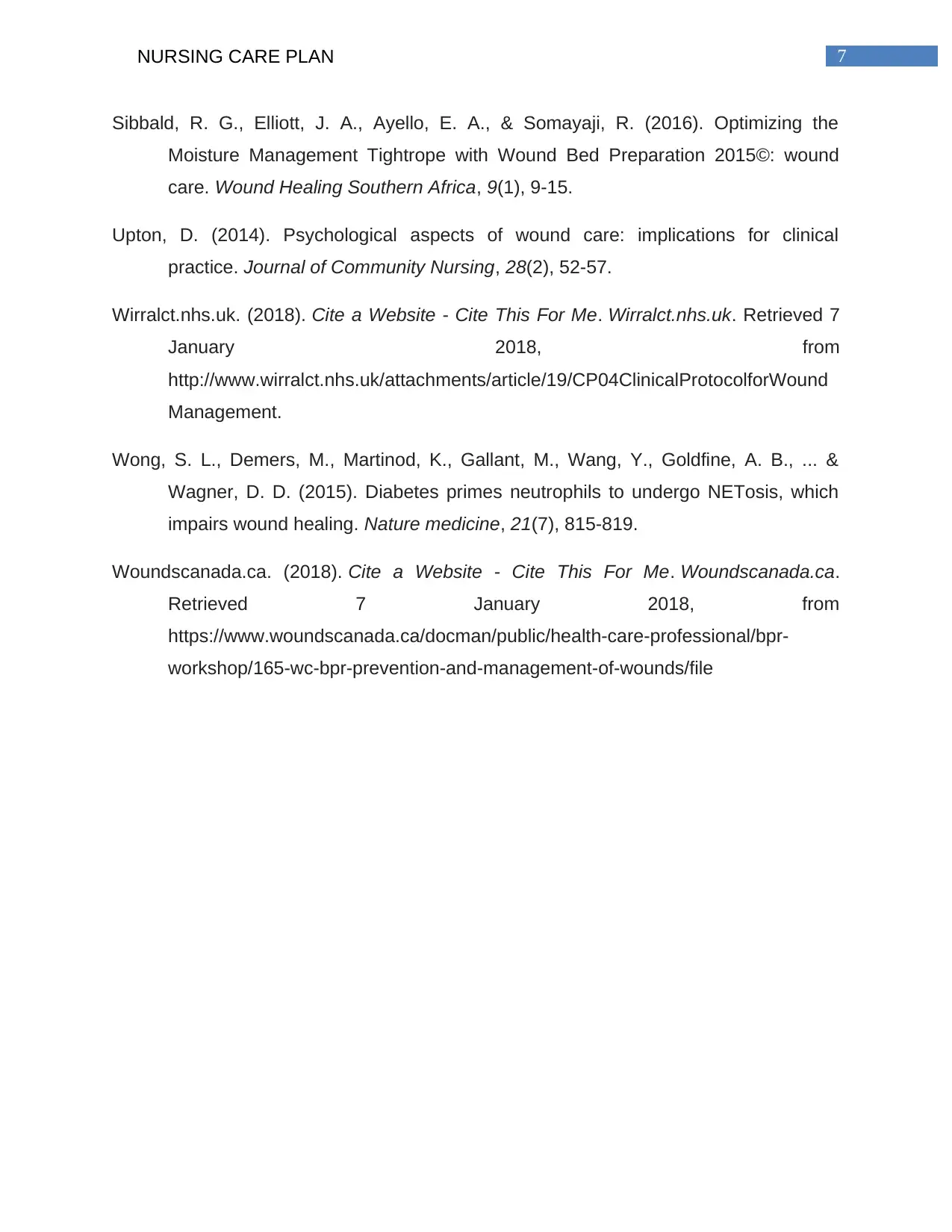
7NURSING CARE PLAN
Sibbald, R. G., Elliott, J. A., Ayello, E. A., & Somayaji, R. (2016). Optimizing the
Moisture Management Tightrope with Wound Bed Preparation 2015©: wound
care. Wound Healing Southern Africa, 9(1), 9-15.
Upton, D. (2014). Psychological aspects of wound care: implications for clinical
practice. Journal of Community Nursing, 28(2), 52-57.
Wirralct.nhs.uk. (2018). Cite a Website - Cite This For Me. Wirralct.nhs.uk. Retrieved 7
January 2018, from
http://www.wirralct.nhs.uk/attachments/article/19/CP04ClinicalProtocolforWound
Management.
Wong, S. L., Demers, M., Martinod, K., Gallant, M., Wang, Y., Goldfine, A. B., ... &
Wagner, D. D. (2015). Diabetes primes neutrophils to undergo NETosis, which
impairs wound healing. Nature medicine, 21(7), 815-819.
Woundscanada.ca. (2018). Cite a Website - Cite This For Me. Woundscanada.ca.
Retrieved 7 January 2018, from
https://www.woundscanada.ca/docman/public/health-care-professional/bpr-
workshop/165-wc-bpr-prevention-and-management-of-wounds/file
Sibbald, R. G., Elliott, J. A., Ayello, E. A., & Somayaji, R. (2016). Optimizing the
Moisture Management Tightrope with Wound Bed Preparation 2015©: wound
care. Wound Healing Southern Africa, 9(1), 9-15.
Upton, D. (2014). Psychological aspects of wound care: implications for clinical
practice. Journal of Community Nursing, 28(2), 52-57.
Wirralct.nhs.uk. (2018). Cite a Website - Cite This For Me. Wirralct.nhs.uk. Retrieved 7
January 2018, from
http://www.wirralct.nhs.uk/attachments/article/19/CP04ClinicalProtocolforWound
Management.
Wong, S. L., Demers, M., Martinod, K., Gallant, M., Wang, Y., Goldfine, A. B., ... &
Wagner, D. D. (2015). Diabetes primes neutrophils to undergo NETosis, which
impairs wound healing. Nature medicine, 21(7), 815-819.
Woundscanada.ca. (2018). Cite a Website - Cite This For Me. Woundscanada.ca.
Retrieved 7 January 2018, from
https://www.woundscanada.ca/docman/public/health-care-professional/bpr-
workshop/165-wc-bpr-prevention-and-management-of-wounds/file
1 out of 8
Related Documents
Your All-in-One AI-Powered Toolkit for Academic Success.
+13062052269
info@desklib.com
Available 24*7 on WhatsApp / Email
![[object Object]](/_next/static/media/star-bottom.7253800d.svg)
Unlock your academic potential
Copyright © 2020–2025 A2Z Services. All Rights Reserved. Developed and managed by ZUCOL.




